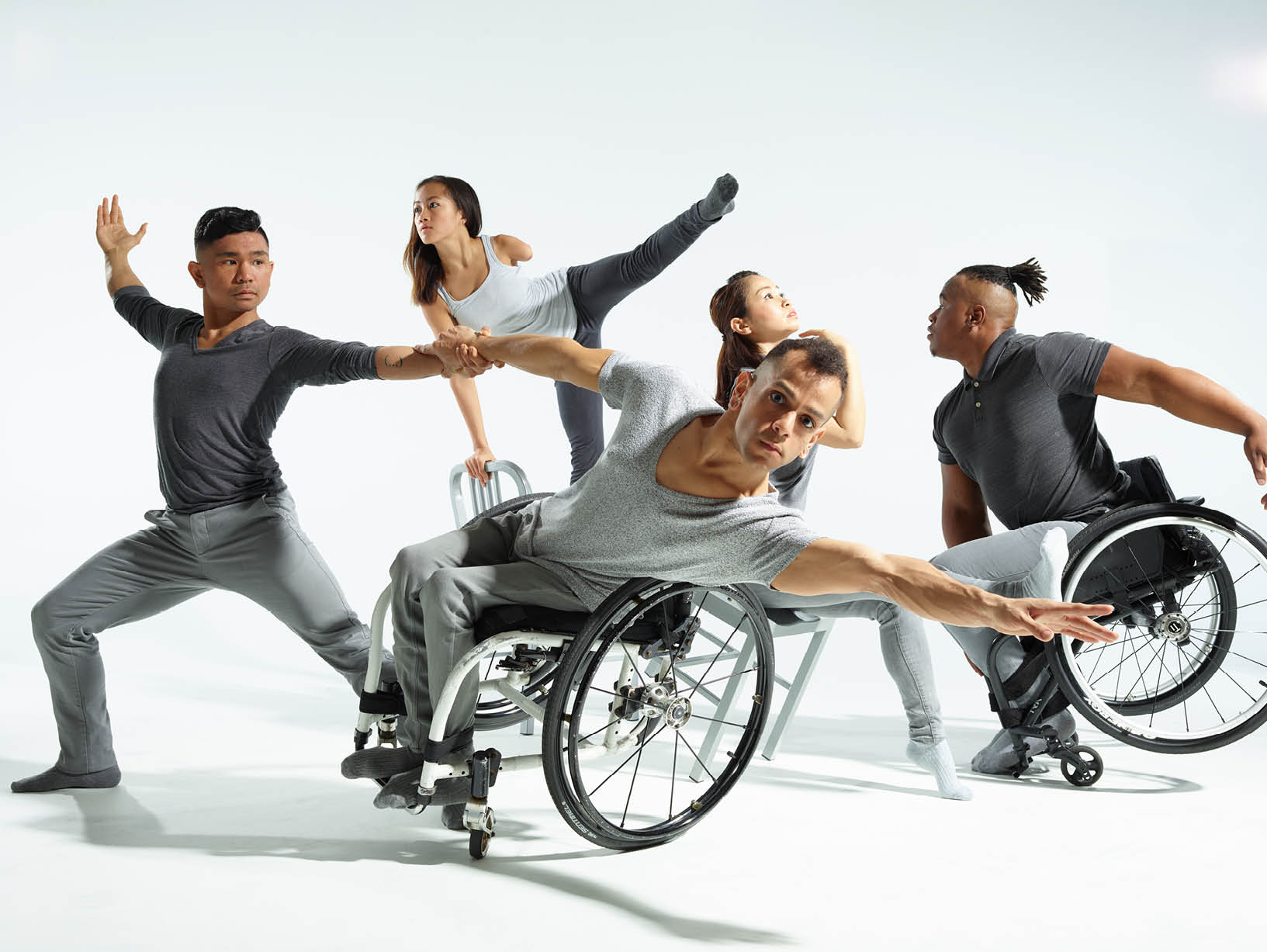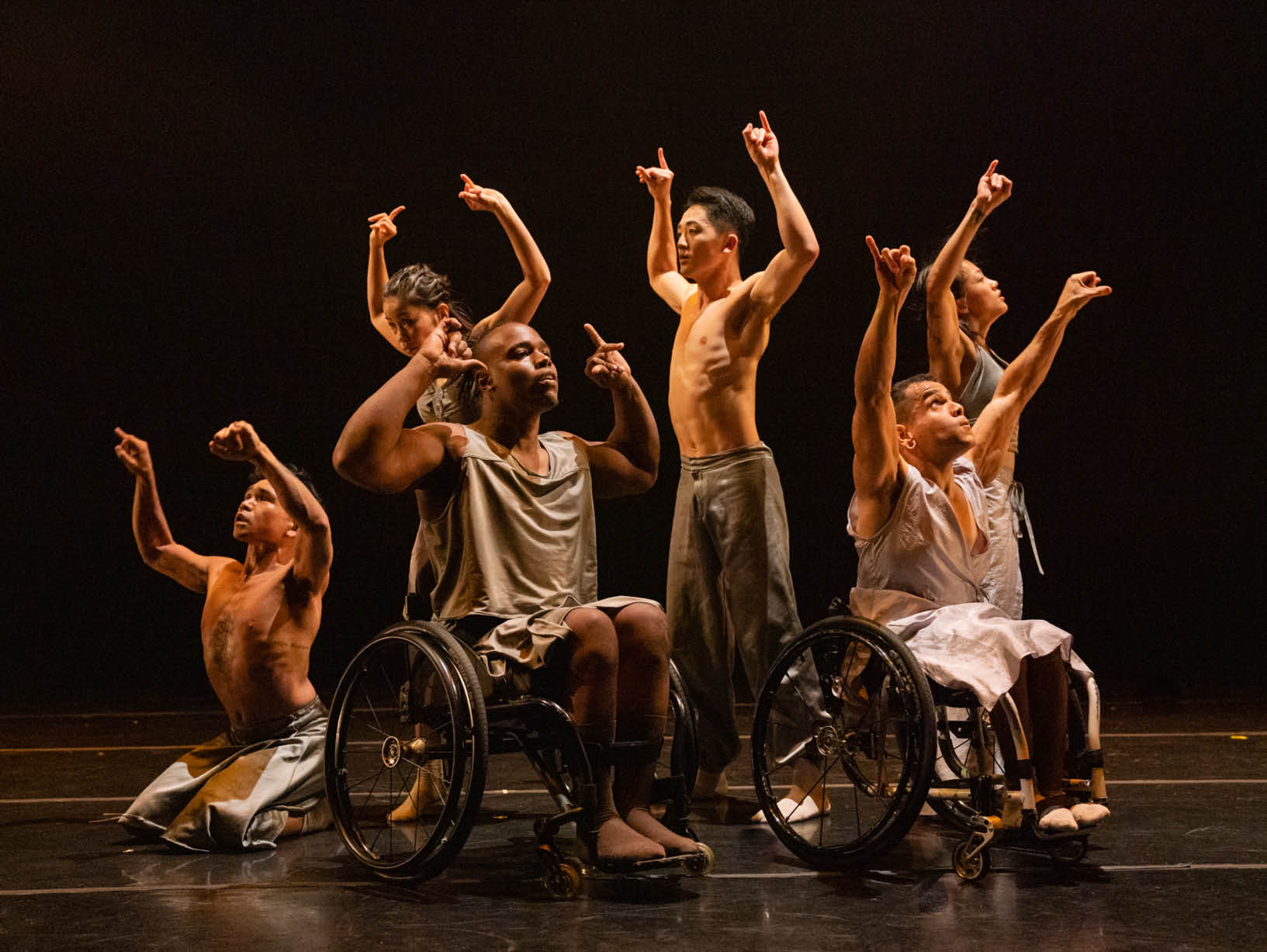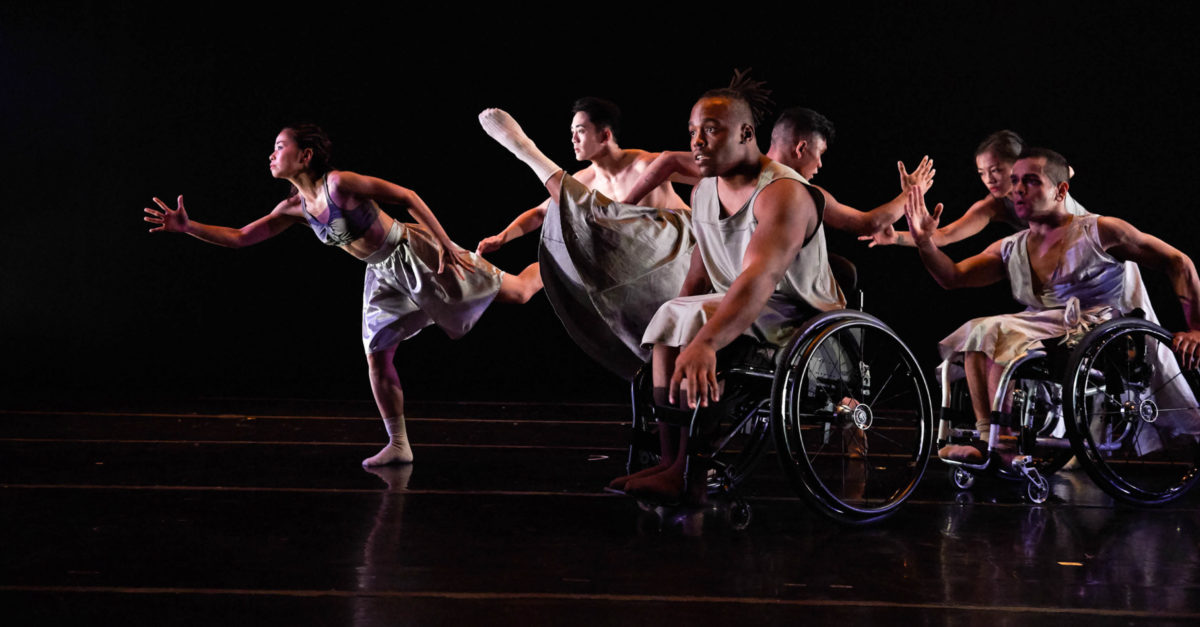The Axis of Dance and Disability
When contemporary dancer Marc Brew sustained a disabling injury in a car crash at the age of twenty, he was disheartened by friends who told him he couldn’t be a professional dancer anymore and urged him to return to school to study something else. There is a short-sighted but common misperception that a disabled person can’t dance. AXIS Dance Company in Oakland, California, seeks to cast aside the traditional and limiting aesthetic of classical dance and reimagine one that welcomes a richer diversity of movement and bodies in space.
Now the artistic director of AXIS, Brew describes the mission of the company as redefining dance and disability through a collaboration between disabled and nondisabled dancers. Brew sees this happening through three pillars, the first being the art itself: “Artistry is the leading part of our work. It’s at the heart of what we do in terms of commissioning, creation, and performance of contemporary dance.” The company incorporates commissions with both established, high-profile choreographers as well as emerging innovators.
The second part of the mission is engagement, which includes its outreach and education work. The outreach program began in 1989 as a direct response to community demand by people who were seeing the performances and wanted to study and work in the field of integrated dance. This could be anything from school assemblies to workshops to master classes to residencies. As Brew explains, “Engagement is wrapped up in the artistry of what we do and helps us to broaden and serve more people.” A silver lining to the COVID-19 pandemic has been the enhanced accessibility of virtual classes, giving disabled dancers around the world an opportunity to try out dance in the safety of their homes.

The final pillar of the mission is advocacy. Brew elaborates, “As a pioneering integrative dance company, it’s really important for us to create opportunities locally and abroad by championing access, inclusion, and equity for people with disabilities both in dance and the wider community.” In the beginning, there were virtually no choreographers who had worked with diverse bodies, and a lot of effort and labor on the part of the dancers was required to essentially train the choreographers on how to make work accessible. These choreographers were really affected by the work and the eye-opening experience and brought a new awareness back to their own companies. Additionally, AXIS began a new program in 2017 called Choreo-Lab, supported by the Mellon Foundation. It brought seven disabled choreographers to the Bay Area to be co-mentored by Brew and disabled choreographer Caroline Bowditch (Australia/UK) in an effort to support emerging disabled choreographers.
Though the similar sound of the words “access” and AXIS seems intentional, the company name actually came from the axis of a wheel. The company was founded in 1987 by a dancer named Thais Mazur, who gathered a group of women to explore movement and create work. The majority of that work in those ten years centered around the personal stories of the dancers in the company and what they brought to the studio. When Judith Smith took over as artistic director a decade later, the company was divided over what direction to take. In the end, Mazur parted ways with AXIS, and the dancers embarked on their goal of commissioning choreographers from outside the company. An early commission with Bill T. Jones, a well-known modern-dance choreographer, put AXIS on the map as a commission company and gave them the jump they needed to begin touring.
The small company consists of a mixture of six dancers with and without disabilities. Traditionally, its nondisabled dancers have all had access to dance degrees and dance training, as opposed to the disabled dancers, who may not have had similar opportunities growing up or in universities. For example, Brew had professionally trained in contemporary dance and classical ballet in Australia and was living and working in South Africa when he acquired his disability. Others who are born with their disability have had to carve out a less traditional pathway
to dance.

When auditioning new members for the company, Brew looks for dancers who have passion, curiosity, fierceness, and a willingness to collaborate well with others. The dancers have different shapes, sizes, bodies, backgrounds, and cultures, and it’s this diversity that adds depth and texture to the works. Emotional and physical check-ins before classes and rehearsals are a daily ritual to empower dancers to have a voice and to advocate for themselves. And a happy side effect of this practice is mutual respect and support among dancers and choreographers. The length of time dancers choose to spend as members of AXIS varies. Some stay for a few years and move on to explore other avenues. Others may stay on for ten years. Some disabled dancers are actually able to have longer careers than their nondisabled counterparts.
A big obstacle that companies like AXIS face is funding. Brew would love to expand the number of dancers in the company, but funding is challenging. It’s a shift from working in the UK and Australia, where there is government funding to obtain ongoing arts funding from an art council or the like. In the US, the funding streams constantly change and affect the security of the company. With that said, AXIS is extremely fortunate to be able to offer dancers a nine-month contract and year-round health coverage. It’s a testament to the hard work of predecessor Judith Smith and the board.
Another hurdle AXIS faces is booking issues. There is a tendency for venues to see physically integrated dance as a box to check off, rather than seeing it as a dance company with its own personal style. AXIS brings work to the table that is relevant to the world we live in. Dancers are cross-trained in different fitness modalities and dance forms, such as improvisation, Pilates, and hip-hop. This diversity in training lends itself to the diverse repertoire AXIS prides itself on. In a recent season, it commissioned Robert Dekkers, a Bay Area choreographer with his own company called Post Ballet, to restage a piece of work called Flutter. Another piece, Petrichor: the smell of earth after rain, was envisioned by Jennifer Archibald, a Brooklyn-based choreographer who is known for fusing hip-hop and ballet and creating driven, emotive work. And the third piece was an international commission by Arthur Pita, who uses narrative as the foundation of his choreography. The piece interwove the idea of Alice in Wonderland with homelessness, creating an exploration between the surreal world and the real world. As a credit to their diversity, the dancers of AXIS are able to tackle these different bodies of work with athleticism and grace.

The landscape of physically integrated dance is changing and improving, but it has a long way to go. As Brew says, “The dance world can be fearful of the unknown. Education needs to happen. I always believe any good teacher who really believes in their craft can make their practice accessible. They may just need to look through a different lens.” Brew often stays away from classical dance vocabulary, which may be unfamiliar to those who didn’t find accessibility in classical ballet classes early on. Instead, he offers visual descriptions of the imagery he wants, like: “We’re going to scoop with the right side of the body and lift it to the top of our head and then tilt to the left side. Roll forward with your body, and let your body hang over your hips and then roll back up through the spine.”
AXIS continues to scoop out its place in the dance world, with an ongoing commitment to building a bridge between contemporary dance, physically integrated dance, and disability culture. The future of dance Brew hopes to see is rooted in the beauty of differently abled bodies moving on stage together in the fullest expression of diversity in movement and human form.
For more info, visit axisdance.org























